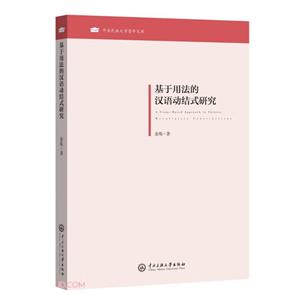-
>
妙相梵容
-
>
基立爾蒙文:蒙文
-
>
我的石頭記
-
>
心靈元氣社
-
>
女性生存戰爭
-
>
縣中的孩子 中國縣域教育生態
-
>
(精)人類的明天(八品)
基于用法的漢語動結式研究/中央民族大學青年文庫 版權信息
- ISBN:9787566021069
- 條形碼:9787566021069 ; 978-7-5660-2106-9
- 裝幀:一般膠版紙
- 冊數:暫無
- 重量:暫無
- 所屬分類:>
基于用法的漢語動結式研究/中央民族大學青年文庫 內容簡介
本書對漢語動結式進行了基于用法的研究,包括語料庫分析和可接受度調查。 首先對于漢語動結式的語料庫研究,基于“現代漢語述補結構用法數據庫”(the Online Database on Verb-Resultative Constructions in Contemporary Chinese ,ODVRC)中列出的結果XP,從蘭卡斯特漢語語料庫(the Lancaster Corpus of Mandarin Chinese,LCMC)收集語料,提出了兩個測試來檢驗漢語結果XP,區分了漢語的邊界和原型動結式。本書對漢語動結式的類型和個數頻次進行了描述性分析,并討論了漢語動結式的類型學分類。 基于語料庫的例句,本書考查結構為[主語+動詞+(賓語)+結果XP]動結式的可接受度,通過問卷調查進行可接受度研究。問卷還調查了“把字句+動結式”的可接受度。調查結果顯示,“把+動結式”的可接受度形成一個連續統,尤其“主語指向動結式”是否加“把”有顯著差異。“把+動結式”的可接受度取決于句子表達的語義及物性的程度。本書提出的認知解釋為,句子表達的高及物性與“把”作為高及物性的標記功能一致。這也支持了學界對“把”字句功能的討論,即將其視為高及物性的標志,而不是表達處置或致使關系。
基于用法的漢語動結式研究/中央民族大學青年文庫 目錄
1.1 Preliminaries
1.1.1 The resultative construction in Mandarin Chinese
1.1.2 The 把 ba-construction
1.1.3 The acceptability of resultative constructions in Mandarin
1.2 Theoretical framework
1.3 Structure of the book
Chapter 2 Literature review
2.1 Introduction and structure of the chapter
2.2 Resultative constructions
2.2.1 Formal approach
2.2.2 Functional-cognitive analysis
2.2.3 General discussion ofresultatives
2.3 The 把 ba-construction
2.3.1 Syntactic analysis
2.3.2 Semantic analysis
2.4 Combinations of resultative constructions and other constructions
2.5 Corpus studies on Chinese resultatives
2.6 Concluding remarks
Chapter 3 Methodology
3.1 Introduction
3.2 Corpus-based approach
3.3 Acceptability judgement approach
3.3.1 Grammaticality verus acceptability
3.3.2 Traditional ways of making acceptability judgements
3.3.3 Magnitude estimation
3.3.4 Questionnaire survey
3.4 Concluding remarks
Chapter 4 A corpus study of Chinese resultatives
4.1 Introduction
4.1.1 Motivation for the corpus analysis of Chinese resultatives
4.1.2 Structure of the chapter
4.2 Methodology
4.2.1 Corpus
4.2.2 Two tests for the identification of Chinese resultatives
4.2.3 Criteria for corpus analysis: classifications of resultatives...
4.3 A corpus study of Chinese resultatives: results
4.3.1 Preliminaries
4.3.2 Classification of Chinese resultatives and more dimensions
4.3.3 A general corpus analysis of Chinese resultatives
4.4 A corpus study of Chinese resultatives: discussion
4.4.1 Chinese resultatives: a typological point of view
4.4.2 Chinese marginal and prototypical resultatives
4.5 Concluding remarks
Chapter 5 把 ba + subject/agent-oriented resultatives:acceptability judgements
5.1 Introduction
5.1.1 Chinese subject-oriented resultative constructions
5.1.2 把 ba + subject/agent-oriented resultatives in Chinese
5.1.3 Structure of the chapter
5.2 The 把 ba-construction: more about high semantic transitivity
5.3 Methodology
5.3.1 Corpus
5.3.2 Questionnaire survey
5.4 The questionnaire survey: results and discussion
5.4.1 Resultatives with and without 把 ba
5.4.2 把 ba + resultatives with and without 終于 zhongyu 'finally'.
5.5 Further implications
5.5.1 Subject/agent-oriented resultatives with postverbal NP
5.5.2 The acceptability of 把 ba + subject-oriented resultatives
5.6 Concluding remarks
Chapter 6 The acceptability of 把 ba + object-oriented resultatives
6.1 Introduction
6.1.1 把 ba + object-oriented resultatives in Chinese
6.1.2 Methodology
6.1.3 Structure of the chapter
6.2 The acceptability of object-oriented resultatives with and without 把 ba
6.2.1 Results
6.2.2 Discussion
6.3 The acceptability of 把 ba + subject-oriented resultatives
6.4 The acceptability of 把 ba + subject-/object-oriented resultatives
6.4.1 Results
6.4.2 Discussion
6.5 Further implications
6.5.1 The acceptability of subject-/object-oriented resultatives
6.5.2 The acceptability of 把 ba+subj ect-/object-oriented resultatives
6.5.3 Subject-oriented resultatives vs. object-oriented resultatives:唱-紅 chang-hong 'sing-popular'.
6.6 Concluding remarks
Chapter 7 Conclusion
7.1 Summary
7.2 Contribution
7.3 Limitations
7.4 Suggestions for further work
References
Appendix A: Chinese Questionnaire surveys of acceptability of Chinese resultatives
Appendix B: English translation of questionnaire surveys of acceptability of Chinese resultatives
基于用法的漢語動結式研究/中央民族大學青年文庫 作者簡介
余爍,女,中央民族大學國際教育學院講師,碩士生導師。2010年獲英國倫敦大學學院語言學碩士學位,2019年獲英國蘭卡斯特大學語言學博士學位。曾應邀赴美國、法國、意大利、巴西、英國等大學和研究機構參加國際會議并發言,主要研究興趣包括認知語言學、構式語法、語料庫研究、二語習得等。
- >
伊索寓言-世界文學名著典藏-全譯本
- >
山海經
- >
羅曼·羅蘭讀書隨筆-精裝
- >
推拿
- >
我從未如此眷戀人間
- >
新文學天穹兩巨星--魯迅與胡適/紅燭學術叢書(紅燭學術叢書)
- >
詩經-先民的歌唱
- >
中國歷史的瞬間

















